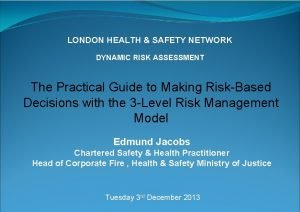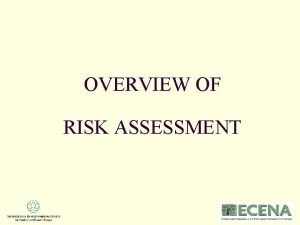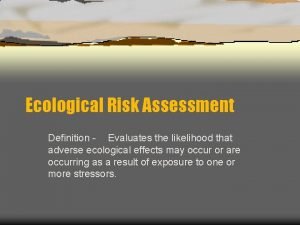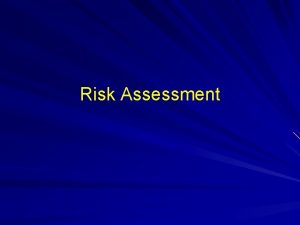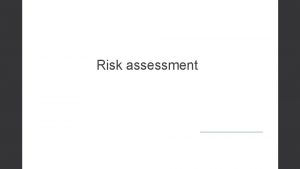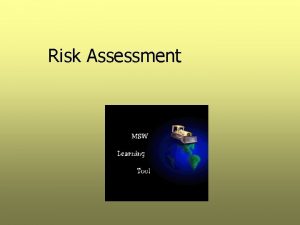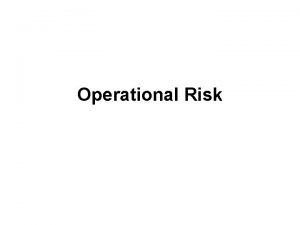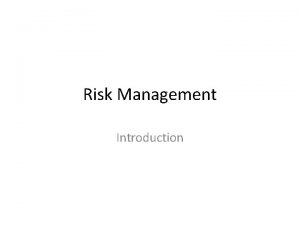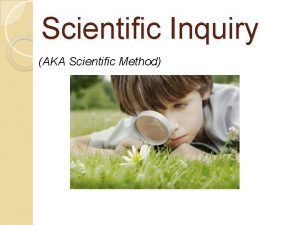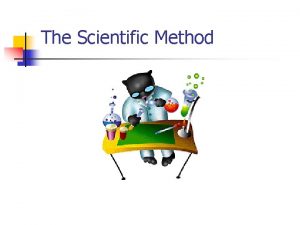Risk Assessment Definition of Risk Assessment A scientific





















- Slides: 21

Risk Assessment

Definition of Risk Assessment • A scientific process of evaluating the adverse effects caused by a substance, activity, lifestyle, or natural phenomenon. • Characterized by uncertainty • Establishes a range of probability

Definition of Risk Factor • Risk Factors increase the probability of disease, injury, or death. (Mc. Kenzie, Pinger and Kotecki, 2002)

Healthy People • Disease prevention and health promotion instead of only finding the cure (since 1979) • Studying the risk factors for getting a disease became increasingly important.

Types of Disease • Communicable (infectious) • Non-communicable • Acute • Chronic

Examples of Risk Factors • • • Obesity Alcoholism Poverty No helmet Tobacco use Environment

Establishing Risk Factors How do we know what the risk factors are?

Analytical Studies • Retrospective • Case • Control • Prospective • Cohort

Considerations of Risk Assessment • • Culture Religion Age Socioeconomics Environment Physical Biology Behavior/attitude Resources

Resource Theory • Define the resource reservoir • Pathways to obtain resources? • Status to obtain resources? • Recognize the lack of resources • Women’s HIV prevention example (Di. Clemente, Crosby & Kegler, 2002)

Risk Vs Resource Need Vs Strength • Needs should be prioritized using the availability of resources. “Giving people medicine for TB and not giving them food is like washing your hands and drying them in the dirt. ” “You want to stop HIV in women? Give them jobs. ” • Resources can be determined by “mapping” a community. Kidder, Tracey, Mountains Beyond Mountains. (2003)

“Ownership” is crucial There is no point in intervening if the community does not feel that they own the problem! (Mc. Kenzie, Pinger & Kotecki 2002)

Prevention Marketing Theory • Step 1: Communitywide risk assessment • Who is doing what, with whom, where, when, how and how often • Step 2: Social Marketing • Commercial marketing principles and techniques achieve socially beneficial goals (Kotler & Zaltman, 1971) (Di. Clemente, Crosby & Kegler, 2002)

Examples of Prevention Marketing • • • Adolescents: “Brain on Drugs” Children and Adolescents: Vaccines All ages: Santa Claus eating cheese All ages: “Got Milk” Children and Parents: Bill Cosby

National Reports • Monthly Vital Statistics • Morbidity and Mortality Weekly Report (MMWR) • Includes outbreaks, environmental hazards

Exemplary Tools of Risk Assessment • Individual • Community/population

Examples of Risk Assessment on the Web • Harvard Center for Cancer Prevention www. yourcancerrisk. harvard. edu • Breast, Prostate, Lung, Colon, etc. • National Institutes of Health www. nih. gov • 10 year risk of heart attack • Memorial Slone Kettering Cancer Center www. mskcc. org • Lung cancer, etc.

Classifying BMI • Underweight • BMI < 5 th percentile • Healthy weight • 5 th > BMI < 85 th percentile • At Risk of Being Overweight • 85 th > BMI > 95 th percentile • Overweight • BMI > 95 th percentile Dennison, Barbara A. , MD, Risk Evaluation in Pediatric Practice, Pediatric Annals (Jan 2004)

Comorbidity! • One risk factor is never enough • A good Risk Assessment identifies all the risks!

National Health Surveys • National Health Care Survey • Behavioral Risk Factor Surveillance • • • System Your Risk Behavior Surveillance System National Health and Nutrition Examination Survey National Minority Substance Abuse and HIV Prevention Initiatives Survey [SAMHSA]

In Conclusion Nurses don’t necessarily need to know 1. The cure 2. The causative agent But we can’t prevent the disease from occurring without knowing the RISK
 Market risk assessment
Market risk assessment Scientific inquiry vs scientific method
Scientific inquiry vs scientific method How is a scientific law different from a scientific theory?
How is a scientific law different from a scientific theory? Health safety
Health safety Risk assessment definition
Risk assessment definition Evaluates definition
Evaluates definition Risk projection
Risk projection Avoidance risk
Avoidance risk Relative risk calculation
Relative risk calculation Residual risk and secondary risk pmp
Residual risk and secondary risk pmp Tracing vs vouching
Tracing vs vouching Absolute risk vs relative risk
Absolute risk vs relative risk Activity sheet 2: stock market calculations answer key
Activity sheet 2: stock market calculations answer key Risk classification system
Risk classification system Pembelanjaan risiko adalah
Pembelanjaan risiko adalah The biggest risk is not taking any risk
The biggest risk is not taking any risk Key risk indicators template
Key risk indicators template Ir x cr x dr
Ir x cr x dr Business risk and financial risk leverage
Business risk and financial risk leverage Attributable risk
Attributable risk Risk map risk management
Risk map risk management Attributable risk
Attributable risk



